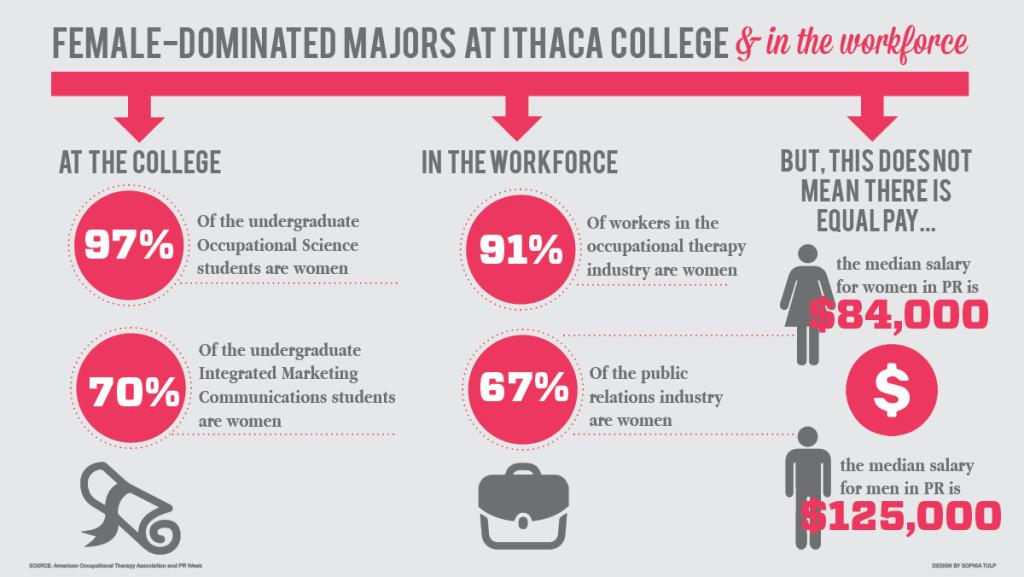Women make up the majority of students at Ithaca College and tend to dominate care-related and media majors at the college and in the workforce. However, some students and experts agree that this majority can tie into negative stereotypes and implications for female workers.
Women make up 59 percent of total enrollment for full-time students at the college. As of Fall 2015, there were 3,963 women and 2,806 men enrolled. In addition to being the majority gender at the college as a whole, women also dominate care-related majors — majors that prepare students to work in fields that help others — like aging studies, occupational therapy and education. Women also dominate media majors including journalism, integrated marketing communications and communication management and design.
All of the 10 students in the gerontology department are women. Mary Ann Erickson, chair of the department, equated this to women’s wanting to be in a “helping profession.” Erickson said the dominance of women in certain majors goes back to gender stereotypes, which can cause a profession to lose financial value when it becomes mostly female.

“I think we still have this idea that men need to be breadwinners, which is very outdated,” Erickson said. “So I think male students are often socialized to think, ‘What can I do that’s going to be high paying?’”
And these jobs that are high paying, research shows, are not those dominated by women. According to a study done by the American Association of University Women, jobs associated with men tend to pay better than women jobs for the same skill level. For example, careers such as OT tend to pay less than a career in physical therapy because one is woman-dominated while the other is male-dominated.
AAUW Senior Researcher Kevin Miller said the disparity in pay is due to the fact that a field loses its prestige when women move into it. Another study done by the AAUW found that on average, one year after graduation, women make 82 percent of what their male classmates make.
Stephen Sweet, associate professor and chair of the Department of Sociology, has recently released the third edition of his book “Changing Contours of Work: Jobs and Opportunities in the New Economy,” which devotes a chapter to exploring questions of gender and its relation to value in society and compensation.
Sweet said after 18 years of socialization, when it comes to choosing a major in college, men and women have received different messages. They usually look at things that “fit” with what they are able to do and what they’ve been told they can do, he said.
“That gets into the question of what does our society value,” Sweet said. “For instance, if we value people who are able to move boxes more than we value people who are able to take care of children and pay them more than that, it says something about how our society makes its gender values known.”
He said one part of the gender and career socialization process, especially for men, is a recognition of where the money is and using that to place value on a position. He said women may be considering the same type of criteria, but an unequal emphasis is placed on this element between the two genders.
Marni Blumenthal, a senior aging studies student, also equated the lack of men in her major to gender stereotypes.
“Within aging studies, you see it as more women are the caregivers,” Blumenthal said. “So you see that there are more women in majors that revolve around care.”
Occupational therapy is another woman-dominated major at the college. Of the 191 undergraduate OT students, five of them are men. The OT program is reflective of the industry, which, according to a 2014 workforce survey performed by the American Occupational Therapy Association, is 91.1 percent female.
Junior Brianna Schiedo said because there are so few men in her OT classes, there is a lack of diversity in opinions.
“You’re with the same people for every class, especially at Ithaca’s program,” Schiedo said. “We don’t have that dynamic balance of guys speaking up and giving their opinions, which are oftentimes different than women’s.”
Although the field is woman dominated, Diane Long, associate professor and chair of the occupational therapy department, said she thinks women occupational therapists aren’t necessarily better than male occupational therapists.
“I have worked with a number of men who are occupational therapists, and they bring wonderful perspectives to clients and the field,” Long said. “I really do think it’s about that socialization that women are the caretakers, and we still embrace that in society.”
Women are not only the majority in care-related majors, but also in integrated marketing communications. Of the 356 undergraduate IMC students at the college, 70 percent are women. This is reflective of the advertising and public relations industries, where many IMC students end up working. According to PR Week’s 2014 Salary Survey, the PR industry is 67 percent women.
This may be explained by studies that suggest that women may be more engaged in collaborative environments. Scott Hamula, strategic communication department chair, said collaborativeness is a quality that excels in the industry, regardless of gender.
“Women tend to have more [collaborativeness] than men do, but obviously some men have it as well, and some women don’t,” Hamula said. “In terms of what the research shows, what certain personality characteristics tend to weigh heavier is valued by the industry.”
Jacqueline Gansky, junior IMC student, saw the difference in treatment between men and women during her internship last summer.
“Even with my boss being a woman … her co-boss seemed to be the one everyone would look at,” Gansky said. “He seemed to be more intimidating and as if he was a person to make the final decision, as if our female boss had to look up to him even though they were on the same level.”
Of the 140 CMD majors at the college, 118 are women and 22 are men, and similarly, of the 214 journalism majors at the college, 143 are women and 71 are men.
However, with journalism comes a different reality reflected in the industry. Although women are dominating the majors at most communications schools across the board, the industry still shows more men. In a report by the American Society of News Editors, newsrooms remain about two-thirds male.
Sandra Fish is the president of the Journalism and Women Symposium — an organization that aims to bring together journalists to share resources about issues women in journalism face. Fish said she has noticed a trend of men being in the hiring positions in newsrooms, which Fish attributes to the disparity between majors and the industry.
“Men end up in hiring roles, and they’re the ones who are promoted,” Fish said. “The lack of upward mobility encouraged women to leave for more lucrative careers … I think men stick around because they … move up.”
Fish said there needs to be a greater emphasis placed on diversifying all fields in terms of gender, not just journalism.
“At some point, male leaders need to take a look around and do more work to promote women,” Fish said. “Women are 50 percent of the population, our society is no longer demographically dominated by white men, and the workplace really needs to reflect that.”








